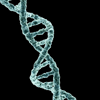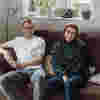Genetics and the Eye
A short guide to the ways that inherited disorders can be passed on through families.

Understanding inherited eye conditions
A diagnosis of an inherited eye condition evokes complex emotions. We know that eye disease impacts generations of families, which means you and your loved ones may be at risk. Different family members may react differently, which can be difficult as well. Being informed can help you to have better conversations with loved ones and the experts overseeing your care, which is why we’ve created this guide to understanding genetics and the eye.
What is the difference between inherited eye conditions and those with a genetic component?
Inherited eye conditions develop because of changes, or faults, in the instructions that our bodies use to grow and work properly.
These instructions are called genes, and we get them from our parents.
When there’s a fault in one of these genes, it can cause problems affecting our eyes or vision. This faulty gene can then be passed from parents to their children. That’s why these inherited eye conditions can often affect several members of the same family across different generations.
Many inherited eye conditions are considered rare. They’re often caused by a change in just one gene out of our many thousands. Because of this, doctors can sometimes predict a person’s risk of developing these conditions by looking at their family history.
Eye conditions with a genetic component
Some more prevalent eye conditions have a genetic component, such as refractive errors, glaucoma, cataracts, and age-related macular degeneration. However, these are a bit different from inherited eye conditions because they usually result from the complex interplay between genetic and environmental factors. There are similarities in how some people are more likely to get cardiovascular diseases or diabetes.
A person’s family history and various environmental and lifestyle factors, such as diet or smoking habits, will determine their likelihood of developing these conditions.

Read Ed and Beth's storyEd and Beth Cameron share an inherited eye condition. The siblings discuss their unique experiences of vision loss.
What are some examples of inherited eye conditions?
Quite a few rare eye conditions are passed down in families. Some examples are:
- Autosomal dominant optic atrophy (ADOA): a condition that affects the optic nerve, which transmits visual information from the eye to the brain.
- Leber congenital amaurosis: A condition that affects babies’ vision from a very young age.
- Meesmann corneal dystrophy: A condition that affects the cornea, the clear surface on the front of the eye.
- Stargardt disease: typically causes vision loss in children and young adults.
Other inherited conditions
Some inherited conditions affect both the eye and other parts of the body, forming part of a broader syndrome. One example is Wolfram syndrome, which causes sight loss and other symptoms such as diabetes and deafness.
How are conditions passed down through families?
Eye conditions that run in families usually follow certain patterns or rules for how the disease is passed down from parents to their children. The three most common ways this can happen are:
1. One parent can pass it on to a child (doctors call this ‘autosomal dominant’).
2. Both parents need to pass on a hidden genetic fault (called ‘autosomal recessive’).
3. It’s linked to the X-chromosome, which determines biological sex (known as ‘X-linked).
Usually, all the families with the same inherited eye condition will share the same pattern. But, the same disease can sometimes be passed down differently in different families. In these cases, the way it is inherited depends on the exact genetic cause of the disease.
An example of an eye condition that can be inherited in different ways is Leber congenital amaurosis. Usually, a child develops it only if both parents pass on a hidden genetic fault. However, in rare cases, just one parent with the condition can pass it on to their child.
Discover more about the group and family funds helping fundraise for us. Many are impacted by inherited eye diseases.

Can I get tested if an inherited condition runs in my family?
If you think you or someone in your family may have an inherited eye condition, it’s best to consult your GP or optician. They can provide an initial assessment and, if necessary, refer you to an ophthalmologist (a specialist eye doctor at the hospital) for further tests to inform a diagnosis. Depending on the results, you may also be referred for genetic testing and support from a genetic counsellor.
What does genetic testing involve?
Genetic testing involves taking a blood or saliva sample to examine your DNA and identify faults in specific genes.
The results can confirm a diagnosis and provide valuable information about inheritance patterns and potential risks to other family members. A genetic counsellor can help you understand the test results and their implications for you and your family and guide you through any decisions you may need to make based on this information.
They can also provide emotional support and connect you with relevant resources and support groups.
Early diagnosis of inherited eye conditions can lead to better management and potential treatment options. If you have any concerns, please seek medical advice from a health professional.
What do we mean when we talk about genes and DNA?
Genes are the fundamental building blocks of our bodies. They are made up of a chemical called ‘deoxyribonucleic acid’, or DNA.
Each of us has around 20,000 genes, which carry our cells' instructions to produce proteins. These proteins perform various vital functions, playing key roles in the body’s growth, development and day-to-day function.
We inherit our genes from our parents. We have two copies of most genes – one from our mother and the other from our father.
Each gene contains the instructions to make a protein with a specific job. For example, some proteins are specialised to respond to light, allowing us to see. Other proteins are integral to our immune system, for example, by helping to identify and eliminate bacteria and viruses.
Decoding the genetics of inherited retinal diseases
What are x and y chromosomes?
Our genes are located on tiny thread-like structures called chromosomes. Each of our cells typically contains 46 chromosomes; one set of 23 chromosomes is inherited from our mother, and another set of 23 chromosomes comes from our father.
Of these 23 pairs of chromosomes, 22 are matching pairs called autosomes that are numbered from one to 22. The 23rd pair, known as the sex chromosomes, differ between males and females. There are two types of sex chromosomes: X and Y.
Typically, females have two X chromosomes (XX), one inherited from their mother and one from their father. Males, on the other hand, typically have one X and one Y chromosome (XY). They inherit one of their mother’s X chromosomes and the Y chromosome from their father.
How do our genes cause disease?
We all have many tiny variations in our DNA, which mostly have little or no noticeable impact on our health. However, specific gene changes – or faults – can be harmful and lead to inherited diseases.
Inherited eye conditions are caused by faults affecting a gene that plays a crucial role in healthy eye development and function. Consequently, the affected protein cannot do its job properly, leading to sight problems.
Most of these gene faults already exist and are passed down through generations from parents to their children. However, a new gene fault can occasionally appear for the first time (or spontaneously) in a person with no family history of that eye condition.
Types of inheritance
Different conditions can be inherited in different ways. You can find out more about the different types of inheritance related to eye conditions by clicking the headings below.
-
What does autosomal dominant mean?
Autosomal dominant is a term doctors and geneticists use to describe how certain conditions are passed down through families. If you are affected with a condition that’s inherited in this way, there’s a 50% chance of passing it on to each of your children, regardless of their sex. Both males and females can inherit and pass on the condition equally, and it often appears across multiple generations of the same family.
Examples of inherited eye conditions that are passed down through families in this way include Autosomal dominant optic atrophy (ADOA) and Meesmann corneal dystrophy.
If you or someone in your family is diagnosed with an autosomal dominant eye condition, your doctor may recommend testing other family members. This can help identify who else might have inherited the faulty gene, even if they don’t have any symptoms yet. You may also want to consider genetic counselling when planning a family. A genetic counsellor can help you understand the implications, guide you through your options, and support you in making informed decisions. -
What does autosomal recessive mean?
Autosomal recessive is a term used by doctors and geneticists to describe how certain conditions are passed down through families. For conditions inherited in this way, both parents must be ‘carriers’ – meaning they carry a copy of the faulty gene, even if they don’t have the condition themselves. Each of their children will have a 1 in 4 (25%) chance of inheriting two copies of the faulty gene and being affected, regardless of their sex.
These conditions affect males and females equally, but may not be seen in every generation of a family. Often, people are unaware they are carriers until a child is diagnosed.
Examples of eye conditions that are usually inherited in an autosomal recessive pattern include Stargardt disease, Leber congenital amaurosis (LCA) and achromatopsia. -
What is an X-linked condition?
An X-linked condition is caused by a faulty gene located on the X chromosome. Because males and females have different combinations of X and Y chromosomes, these conditions are passed down differently for each sex.
Since males have one X chromosome and one Y chromosome, if they inherit a faulty gene on the X chromosome, they will typically have the condition. However, as females have two X chromosomes, they can carry the faulty gene without having the condition because the healthy copy of the gene on the second X chromosome often compensates. However, they can still pass on the faulty gene to their children.
In families affected by an X-linked condition, the condition is often seen in males across the generations, while females may appear unaffected but act as carriers. Sons of affected fathers will not inherit the condition. If a mother is a carrier, each of her sons has a 50% chance of inheriting the condition.
Examples of X-linked conditions include choroideremia and ocular albinism type 1 (OA1), which is also known as X-linked ocular albinism or Nettleship-Falls ocular albinism. Both of these conditions usually only affect boys. -
What is maternal/mitochondrial inheritance
Each of our cells contains many thousands of mitochondria, which produce the energy they need to stay healthy. While most of our DNA is stored in our chromosomes, mitochondria also have their own DNA, called mitochondrial DNA (mtDNA). Sometimes, there can be faults in mtDNA genes that can cause diseases that are passed down from mothers to their children.
In families affected by mitochondrial (or maternal) inheritance, the condition is passed down exclusively from the mother, as only egg cells contribute mitochondria to the embryo. Both males and females can be affected, but only mothers can pass the condition to their sons and daughters. However, the severity of the condition can vary, depending on how many mitochondria with faulty mtDNA a child inherits from their mother.
An example of an inherited eye condition that follows a mitochondrial inheritance pattern is Leber hereditary optic neuropathy (LHON).
Discover more about eye conditions including inherited eye disease in our A to Z.

-
Understanding inherited eye conditions
-
Genes and DNA
-
Inheritance types explained
- Understanding inherited eye conditions
- Genes and DNA
- Inheritance types explained